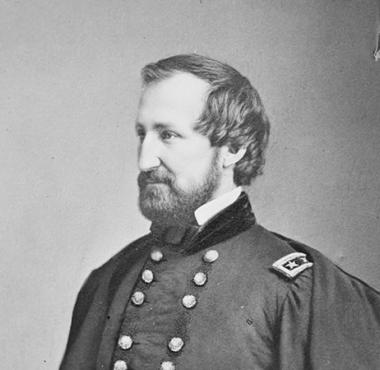(September 6, 1819 – March 11, 1898)
William Starke Rosecrans was born to Crandell Rosecrans and Jane Hopkins in Delaware City, Ohio. His great-grandfather was a governor of Rhode Island, a signer of the Declaration of Independence, and a co-author (with John Adams) of a draft of the Articles of Confederation.
Like many during his age, Rosecrans received only an informal education, but he demonstrated his intelligence and intellectual curiosity early and read everything he could get his hands on. He landed an appointment to West Point and graduated from the military academy in the Class of 1842. His standing (5th out of 56) placed him near the top of one of the most notable classes in the institution’s illustrious history. His classmates included future Civil War generals John Newton, James Longstreet, Richard H. Anderson, George Sykes, Abner Doubleday, Seth Williams, Alexander P. Stewart, Lafayette McLaws, Mansfield Lovell, John Pope, Daniel Harvey Hill, and Earl Van Dorn. Rosecrans roomed at West Point with Longstreet and Stewart, two generals who would later play a major role in ending his tenure as an army commander.
Rosecrans entered the engineers because of his class standing, but resigned in 1854 in order to pursue a civilian career path that would include stints as an architect, civil engineer, mining executive, and running a navigation company launched to haul coal. “Old Rosy” was also a prolific inventor. Unfortunately, he was working in a coil-oil production laboratory in 1859 when a lamp exploded, burning much of his body. Somehow he managed to walk more than one mile home. His injuries were so severe that he was confined to bed for the better part of two long and painful years. The scars on his forehead remained visible for the rest of his life.
Unlike many of the top commanders who would fight the Civil War, Rosecrans had not fought in the US-Mexican War (1846–48) or in the conflicts with the Indians. He was, however, an extraordinary engineer and businessman, specializing in the coal-mining industry. Not only did he map the richest coal veins in western Virginia (present-day West Virginia), he led a navigation company specializing in coal transport, and he invented improvements in mining and other industries. A miner safety lamp of his own design exploded while he was testing it in his laboratory, resulting in severe burns that confined him to bed for a year and a half. He volunteered for Civil War military service even before he had fully recovered.
Rosecrans’s initial assignment was as drill-master of Ohio’s “Marion Rifles” regiment. He was next assigned to lay out the plan for Camp Dennison, Ohio, after which he was promoted to colonel and made commanding officer of the 23rd Ohio Volunteer Infantry. Promoted to brigadier general in the regular army (effective May 16, 1861), Rosecrans served under George B. McClellan and was largely responsible for the Union victory at the Battle of Rich Mountain (July 11, 1861, Virginia). Nevertheless, McClellan both claimed and received full credit, an action that prompted Rosecrans to secure a transfer to the Western Theater and out of McClellan’s command.
Rosecrans took command of the left wing of the Army of the Mississippi at the Battle of Iuka (September 19, 1862, Mississippi; Union victory) and the Siege of Corinth (April 29–May 30, 1862, Mississippi; Union victory). Despite this success in siege and battle, Major General Ulysses S. Grant complained that Rosecrans was negligent for having failed to pursue Confederate forces after the battle. Rosecrans responded, in turn, by blaming Grant for failing to reinforce him. Regardless of the dispute, Rosecrans assumed command of the Army of the Mississippi from June 26, 1862, until October 24, 1862, when it was dissolved (temporarily, as it turned out).
From command of the Army of the Mississippi, Rosecrans, promoted to major general in the regular army, was assigned command of XIV Corps. He led the fight at the Battle of Stones River (December 31, 1862–January 2, 1863, Tennessee; Union victory). Following this, he reorganized his corps into the Army of the Cumberland and went on to conduct the Tullahoma Campaign (June 24–July 3, 1863, Tennessee; Union victory), driving the Confederates away from Chattanooga.
Rosecrans sullied his record of competence and success by his faulty conduct at the Battle of Chickamauga (September 19–20, 1863, Georgia; Union defeat) when, in the confusion of a chaotic battle, he created a gap in his own lines and, under intense attack, prematurely withdrew from the engagement. (The Army of the Cumberland was saved only by the steadfastness of Major General George H. Thomas, the “Rock of Chickamauga.”) Relieved of command of the Army of the Cumberland, Rosecrans was later assigned command of the Department of Missouri, which he held through the end of the war. Rosecrans resigned his commission in 1867, resumed his business career, and was later appointed US minister to Mexico (1868–69). Elected to Congress as representative from California’s 1st District in 1881, he served until 1885 and was then appointed register of the US Treasury. He died in 1898.
